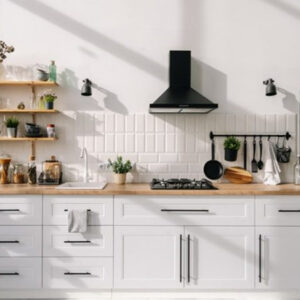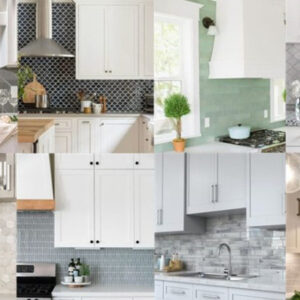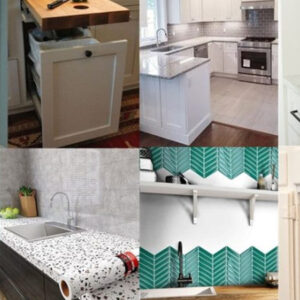
Whether you realize it or not, you and your guests spend a lot of time in your bathroom. Every time you go to wash your hands, brush your teeth, shower, use the bathroom, put on makeup, or get ready for bed, you’re in the bathroom.
This means it’s an important part of your home and you want it to feel bigger and more integral than it likely does. Small bathrooms often have a sense of compactness and even slight claustrophobia. With these small bathroom shower tile ideas, you can create a sense of depth and relaxation in your bathroom.
9 Small Bathroom Tile Shower Ideas
If not done right, tile may make a small bathroom feel even smaller. But you don’t have to stick with low-quality plastic tubs and showers. If you do it right, tile can actually elevate a small bathroom shower to make the whole space feel larger or taller.
1. Bright and Colorful
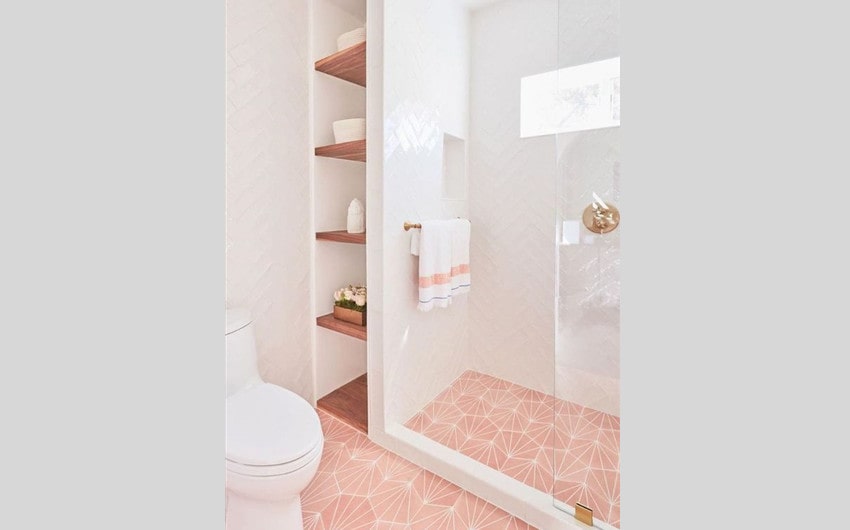
Image source: Pinterest
Most people think about adding colorful tiles to the wall or in a stripe, but a great way to brighten the whole space is to use colorful floor tiles with geometric patterns. Picking a bright color to pair with a glossy white wall brightens up the space considerably without being too tacky.
To make the floor color fit in more, pick out a few accessories that match, such as flowers in the same color and towels with a matching stripe. You don’t want everything to be the same color, but one or two hints of it also scattered throughout the room provide a sense of harmony.
Make the shower seem even bigger by adding subtle movement. The tiles on the shower wall are in a herringbone pattern facing upwards to make the shower feel taller, but the high-gloss white tiles with white grout make it hard to notice the pattern right away so it reads more subtle.
2. Add a Feature Wall
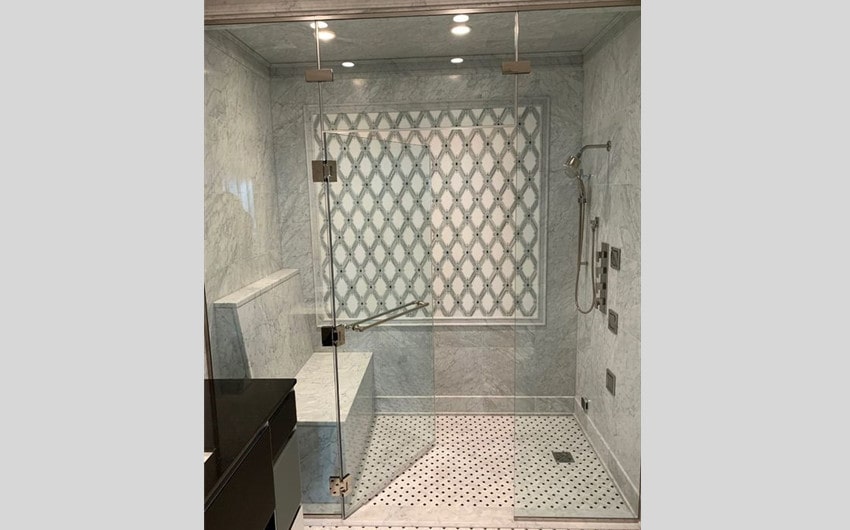
Image source: Pinterest
If your bathroom is long but narrow, you want to draw the eye all the way to the back, usually where the shower is. A feature wall, or square on the wall, reads like a painting. It detracts the eye from the narrowness and gives the impression of more depth than is actually there.
To make the most of a feature wall, the other tiles and colors in the bathroom should be muted. In the picture above you see that the shower has a fairly plain gray-colored tile stacked right on top of each other. The floor should also be relatively plain, though the contrast of the dots on the feature wall and the dots on the tile actually assist each other in this case.
The feature wall then needs to be much more eye-catching. You can do this with a different tile stack, such as herringbone, or with a bright color and different tile shapes. In this picture, they used tile that still kept the gray and white coloring from the rest of the bathroom but put it together with a fun mosaic tile. They also actually framed the square to make it feel more incorporated.
3. Don’t Let the Darkness In
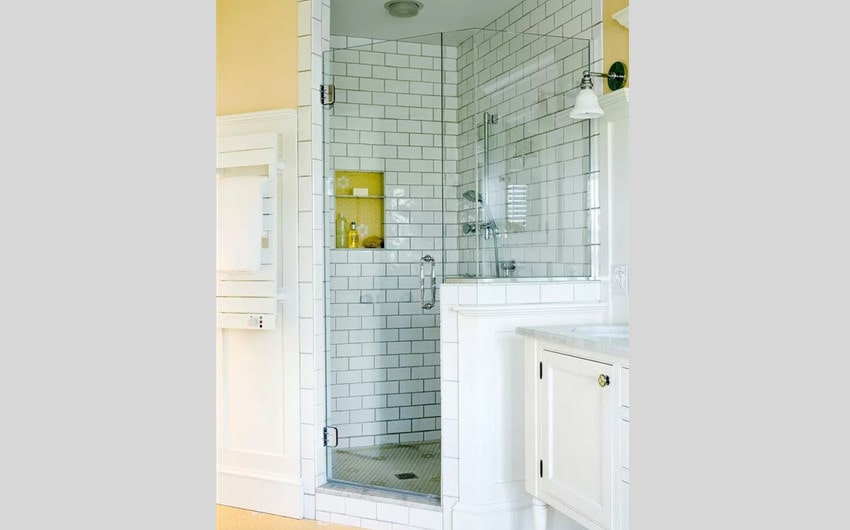
Image source: Pinterest
If you have a corner shower without any skylights or windows in it, the space likely often feels dark unless you have all the lights on. Using a dark tile or even a gray tile will accentuate the shadows and make the shower appear even darker.
The shadows make the space feel smaller and more cramped. Darkness tends to make a room feel smaller, especially when there isn’t enough light to mitigate the effects. Dark tile on the floor is fine, but the walls and especially the ceiling need to be bright.
To fight against the dark shadows, add a bright color to your corner shower. You can use something as simple as a glossy white tile with white grout. The picture shows darker grout, but it accentuates the shower, especially near the bottom, and makes the space seem dingy.
If you’re going to use white tile, consider painting your walls a bright, cheerful color so that the white tiles catch it. You can also add hints of color, such as the small shelf in the shower, to add a little extra brightness and a pop that catches the eye.
4. Add Contrast
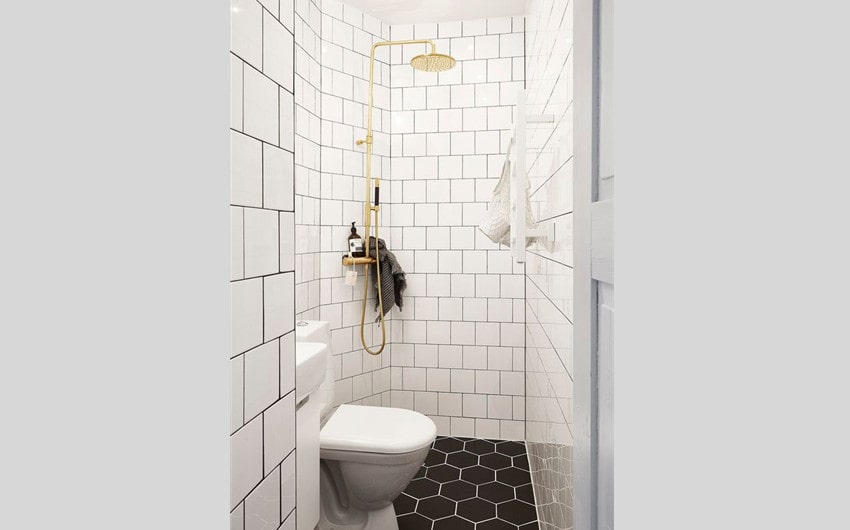
Image source: Pinterest
If you have a really small bathroom, adding contrast can make the space seem much larger. This can be as simple as a dark-tiled floor with a bright wall. The dark grout with the white and the white grout with the dark allows a sort of flow between the floor and the wall.
To get the most out of this contrast, install bright white lights in the bathroom. Shiny and bold finishes can also attract the eye, such as the color of the showerhead in this picture. Brightness makes places feel more open, even if there isn’t much space at all. Generally, you don’t want to go with very dark colors unless you have a lot of light or a lot of space.
If you don’t want a lot of colors but still want your space to look bigger, this contrast is your best option. The two different tiles’ shapes and sizes further add to the contrast and make the floor feel like a new space instead of a solid object so at a glance the space feels large.
5. Expand to the Whole Bathroom

Image source: Pinterest
A shower with glass walls tucked into a corner often makes a bathroom feel smaller. The walls and extra steps around the shower feel blocky and cut off the flow to the rest of the space. If only half the wall is glass and the rest is tiled so it gets dark, like shown above, the best option is to add brightness.
However, if you can make all of the walls glass with just a few metal pieces to hold them all together, you may be able to create more of a flow with your bathroom tile. As shown in this picture, but only having a small glass wall separating the shower from the rest of the bathroom, the space doesn’t feel as closed off, and it makes the rest of the bathroom feel bigger too.
Carrying your tiles over from the shower to the rest of the bathroom further creates that flow and connection. Even with the step between the rest of the floor and the shower floor, the space feels open.
6. Add Depth With Deep Colors

Image source: Pinterest
Earlier, this article expressly mentioned not to use dark walls within a small bathroom. However, it is possible to do when just a little is used and with the right lights.
With the rest of the bathroom using marbled white and gray tile, the dark, wood-like tile stands out. First, it’s the only area in the bathroom with movement. The horizontal tiles add a feeling of more width in the shower than is available.
Additionally, though the tile is dark, the natural wood and different shades on the tile make it much more appealing than a solid, dark tile would be. The dark color at the end of the bathroom also provides a sense of depth to make the whole room feel elongated, especially when the marble tile carries to the rest of the shower’s walls and floor.
Though it’s hard to do right, the way this shower is done makes it feel snug and comfortable, rather than too tight and small. The dark wall makes it feel like it’s meant to be small to provide you with a relaxing shower, instead of like the bathroom was designed poorly.
7. Add Different Types of Movement

Image source: Pinterest
This one isn’t easy to do, and it’s highly recommended you hire a professional designer to plan out this kind of design. Otherwise, you end up confusing and repulsing the eye, rather than creating a sense of movement.
However, if you do manage to do it right, the various patterns, textures, and colors create a sense of depth while remaining interconnected. The wavy tiles that take up a majority of the shower flow well with the rest of the bathroom floor tile. It also adds texture and a horizontal movement feel.
Then there is the inside shower floor. This uses stones and cement to create an uneven texture and color scheme. Though it uses earth tones instead of gray, the tones are dark and neutral enough to work well with the wall.
This color carries on to the horizontal strip up on the wall of the shower. The tones match that of the floor and create an arrow pointing left in the bathroom. This matches the horizontal feel of the gray tiles and connects to the floor with the matching colors.
If you look closely, you’ll also notice that the glass tiles in the nooks have the same color. The various sizes and shapes of the tiles create a sense of movement and depth without detracting the eye from the rest of the space.
It’s a strange mix of confusing the eye, something often seen as bad, while still making the space feel connected. It’s definitely not easy to do, but makes for a unique and larger-feeling shower if done right.
8. Move Up

Image source: Pinterest
Creating a sense of flow is one of the biggest factors when trying to make your bathroom feel bigger. You don’t want tiles that take the eye to the wrong place, or that make the space feel still and flat.
This picture shows the importance of flow. The floor tile runs towards the bathtub, attracting your eye and causing your attention to go from the floor at your feet to deeper in the bathroom. Then, the exact same tile is behind the tub, continuing the same movement, but now going up.
This sense of movement makes the space feel like it has more length and height than is really there. The flow shown in this picture would work best for a bathroom that has a glass shower. A shower curtain would only detract from the movement, which is why the shower curtain was removed before the picture was taken.
9. Mimic a Waterfall

Image source: Pinterest
Waterfalls are the epitome of movement. They create a constant flow from the top of a rock or mountain down into a body of water below. In a bathroom, where water is a main feature, it’s a fun trick to mimic the movement.
As you can see in the picture, it’s a good idea to start with a simple tile for the rest of the shower space. Like the feature wall from above, you want to keep the rest of the space simple so it doesn’t clash with the area you want to attract attention to. A simple subway tile or marble with minimal color variation in it with subway or stacked tiles often works best.
Then your waterfall movement. Like the feature wall, this one is framed, though minimally. The tiles change not only in size but in shape. In this case, they are small hexagons, though herringbone, ovals, or mismatched glass tiles also work well.
The coppery-blue color further creates the feeling of a waterfall, as blue is often associated with water. The slight variation between every tile further creates a sense of movement and depth.

